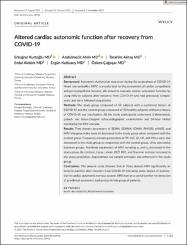| dc.contributor.author | Kurtoğlu, Ertuğrul | |
| dc.contributor.author | Afşin, Abdulmecit | |
| dc.contributor.author | Aktaş, İbrahim | |
| dc.contributor.author | Aktürk, Erdal | |
| dc.contributor.author | Kutlusoy, Ergün | |
| dc.contributor.author | Çağaşar, Özlem | |
| dc.date.accessioned | 2021-11-29T19:11:06Z | |
| dc.date.available | 2021-11-29T19:11:06Z | |
| dc.date.issued | 2021 | en_US |
| dc.identifier.citation | Kurtoğlu, E., Afsin, A., Aktaş, İ., Aktürk, E., Kutlusoy, E., & Çağaşar, Ö. (2021). Annals of Noninvasive Electrocardiology : the Official Journal of the International Society for Holter and Noninvasive Electrocardiology, Inc. 2021: e12916. | en_US |
| dc.identifier.issn | 1082-720X | |
| dc.identifier.issn | 1542-474X | |
| dc.identifier.uri | https://doi.org/10.1111/anec.12916 | |
| dc.identifier.uri | https://hdl.handle.net/20.500.12899/501 | |
| dc.description.abstract | Background: Autonomic dysfunction may occur during the acute phase of COVID-19. Heart rate variability (HRV) is a useful tool for the assessment of cardiac sympathetic and parasympathetic balance. We aimed to evaluate cardiac autonomic function by using HRV in subjects after recovery from COVID-19 who had previously symptomatic and were followed outpatiently.
Methods: The study group composed of 50 subjects with a confirmed history of COVID-19 and the control group composed of 50 healthy subjects without a history of COVID-19 and vaccination. All the study participants underwent 2-dimensional, pulsed- and tissue-Doppler echocardiographic examinations and 24-hour Holter monitoring for HRV analysis.
Results: Time domain parameters of SDNN, SDANN, SDNNi, RMSSD, pNN50, and HRV triangular index were all decreased in the study group when compared with the control group. Frequency domain parameters of TP, VLF, LF, HF, and HFnu were also decreased in the study group in comparison with the control group. LFnu was similar between groups. Nonlinear parameters of HRV including α1 and α2 decreased in the study group. By contrast, Lmax, Lmean, DET, REC, and Shannon entropy increased in the study population. Approximate and sample entropies also enhanced in the study group.
Conclusions: The present study showed that all three domain HRV significantly altered in patients after recovery from COVID-19 indicating some degree of dysfunction in cardiac autonomic nervous system. HRV may be a useful tool for the detection of preclinical autonomic dysfunction in this group of patients. | en_US |
| dc.language.iso | eng | en_US |
| dc.publisher | Wiley | en_US |
| dc.relation.isversionof | 10.1111/anec.12916 | en_US |
| dc.rights | info:eu-repo/semantics/openAccess | en_US |
| dc.subject | Heart rate variability | en_US |
| dc.subject | Holter/event recorders | en_US |
| dc.title | Altered cardiac autonomic function after recovery from COVID-19 | en_US |
| dc.type | article | en_US |
| dc.authorid | 0000-0001-5835-087X | en_US |
| dc.authorid | 0000-0001-6393-2380 | en_US |
| dc.department | MTÖ Üniversitesi, Tıp Fakültesi, Dahili Tıp Bilimleri Bölümü | en_US |
| dc.contributor.institutionauthor | Kurtoğlu, Ertuğrul | |
| dc.contributor.institutionauthor | Aktaş, İbrahim | |
| dc.contributor.institutionauthor | Kutlusoy, Ergün | |
| dc.identifier.startpage | 1 | en_US |
| dc.identifier.endpage | 6 | en_US |
| dc.relation.journal | Annals of Noninvasive Electrocardiology | en_US |
| dc.relation.publicationcategory | Makale - Ulusal Hakemli Dergi - Kurum Öğretim Elemanı | en_US |


















